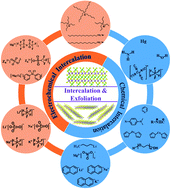Large-scale preparation of single-layer transition metal dichalcogenides (TMDs) is significant due to their potential applications, such as catalysis, electronics, energy storage and conversion. In order to meet the application requirements, TMD nanosheets need to be mass-produced with a high yield, uniform size, and good quality. Several strategies have been developed to prepare 2D TMDs, such as mechanical exfoliation, chemical vapor deposition, and liquid exfoliation. Liquid exfoliation, which can be categorized into direct exfoliation and intercalation-based exfoliation, is a promising method since it can be employed for mass production, structural modification, and fabrication of 2D TMD composites. Intercalation can expand the interlayer spacing, weaken the van der Waals force, and change the structure of the host materials. Exfoliation can break the van der Waals force between the adjacent layers by exerting certain external strengths. However, the detailed mechanisms of both intercalation and exfoliation are not clear; this limits their potential applications. This review aims to provide a comprehensive summary about the intercalation and exfoliation processes of layered materials as well as their properties and applications. Our main attention is the underlying reaction mechanism during chemical or electrochemical intercalation in addition to the exfoliation process. The applications of 2D TMDs fabricated from exfoliation are also introduced in this review. In the last part, we provide some perspectives on the fundamental research and practical applications of TMDs.

